
The Smurfs were introduced in Peyo’s “Johan and Peewit” (1958)
Suspended Animation #399
Producer Joe Barbera said in 1982, “Even though they’re a happy little group of Smurfs, they have problems too. That’s what life is all about. The days of showing little elves playing around a mushroom are gone forever.
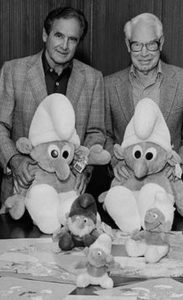 “Our job as adaptors has been to preserve the qualities that make Peyo’s Smurfs so special, while also using our abilities and experience to allow the animated Smurfs to stand on their own as cartoon stars. For a long time you couldn’t give fantasy away. I had to fight to get them to give us an hour.”
“Our job as adaptors has been to preserve the qualities that make Peyo’s Smurfs so special, while also using our abilities and experience to allow the animated Smurfs to stand on their own as cartoon stars. For a long time you couldn’t give fantasy away. I had to fight to get them to give us an hour.”
It may seem that the animated versions of The Smurfs have been around forever and they certainly seem unable to die with new efforts continually being pumped out although now using CGI. A new animated television series produced in Belgium debuted in 2021.
However, when the Belgian comic book characters debuted on American television in 1981 they were not considered a “sure thing” although they eventually lasted for eight years with seven prime time television specials.
Created in 1957 by the Belgium cartoonist Peyo (Pierre Culliford) in a children’s book, the Schtroumpf (the Flemish word for “watchamacallit”) quickly became one of Europe’s most popular comic characters.
“Schtroumpf” became the more familiar “Smurf” when the strips were translated into English. Each Smurf is blue and named after his personality or trade. These Smurfs work together, play together and have any number of wild adventures. They were hugely popular in Europe with many comic albums as well as heavily merchandised.
It wasn’t until 1979 that these characters began coming over to the U.S. via the Wallace Beerie Company. Fred Silverman, then president of NBC, bought his daughter Melissa one of the dolls in a toy shop in Aspen, Colorado. He commissioned Hanna-Barbera to develop a series, even though NBC had earlier rejected a proposal for a Smurf series.
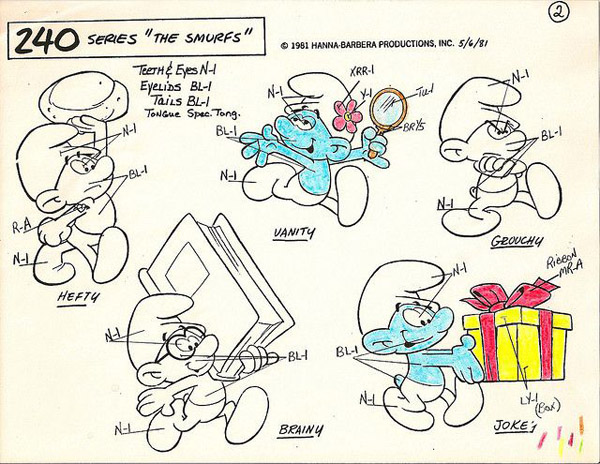
For the United States though some changes had to be made. The biggest change was the addition of a new character, Smurfette. Peyo’s creation was a totally male universe. There were no females with the exception of some humans. To explain the presence of a single woman, the story crew devised a story where the Smurfs main nemesis, a generally inept sorcerer named Gargamel, creates a female Smurf to trap the blue creatures.
However Papa Smurf uses his magic and turns the scheming vixen into the ever friendly and helpful, Smurfette. (Actually, Peyo used a similar story to introduce a Smurfette in one of his comic adventures, but she did not remain as a regular character.)
This change, along with all the writing and drawing, was under the continual supervision of Peyo. Hanna-Barbera had regular meetings with the creator in Europe where they would show sketches and talk over story ideas.
Peyo also visited the studio several times a year. He had veto power over any storyline, character design, or drawing he didn’t like. In fact, this became somewhat of a problem during the first few shows. Peyo would look at a frame of film and state the drawing was wrong and out of proportion.
The studio had to explain that in animation, the characters would stretch and squash in single drawings, but that it was necessary for the movement to look natural. Peyo had to use an interpreter to communicate with the U.S. studio.
Hanna-Barbera put a special staff in charge of the production headed up by Gerard Baldwin. In the initial years of the show, Baldwin was both producer and story editor. In 1985 Baldwin left the series and several other hands then took over the reins.
Key writers in the first years were Peyo, Baldwin, Yvan Delporte, Len Janson and Chuck Menville. Al Gmuir was in charge of creating the background styles while Phyllis Craig was key colorist.
To voice the head Smurf (Papa Smurf), Hanna-Barbera brought in one of their most reliable veterans, Don Messick. For the continuing villain Gargamel (and others such as Nosey and Baby), Paul Winchell (Jerry Mahoney and Disney’s Tigger) loaned his tones.
Master voice man Frank Welker (Dynomutt, Slimer, Foofur, etc.) spoke for Hefty, Poet, Peewit, Clockwork and others. Other animation greats included Lucille Bliss (the original Crusader Rabbit) as Smurfette and June Foray (Rocky the Flying Squirrel) as Jokey, Mother Nature, etc. Others who supplied voices for Smurfs over the years include Arte Johnson (LAUGH-IN), Alan Young (Disney’s Scrooge McDuck), Avery Schrieber, Janet Waldo (Judy Jetson) and Ed Begley, Jr.
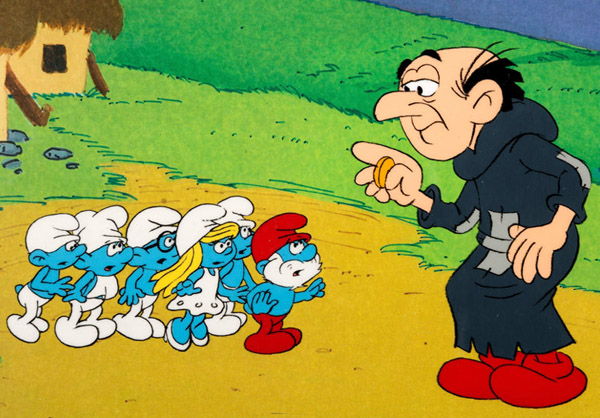
The series debuted as a one hour show September 12, 1981 and quickly became the top rated show on Saturday morning. Though some critics cringed at the soft cuteness in the show, kids couldn’t get enough of these little blue friends.
The show was getting a 44 share, meaning 44 out of every 100 TVs turned on were tuned into the Smurfs. It took NBC from the number three spot to the top rated network for the year. This promptly cancelled NBC’s plans to replace animated shows on Saturdays with a new weekend edition of the TODAY show. NBC retained the top spot for almost the rest of the decade, thanks to the continuing strength of the Smurfs.
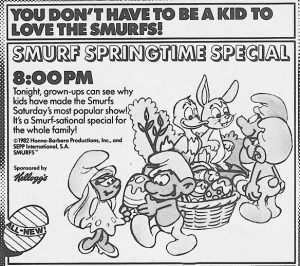 Hanna-Barbera gained a new prominence in the animation community due to the quality of the series. Though aimed at young children, the series was well done with generally strong stories, good graphics, a distinctive, classical music score and competent animation.
Hanna-Barbera gained a new prominence in the animation community due to the quality of the series. Though aimed at young children, the series was well done with generally strong stories, good graphics, a distinctive, classical music score and competent animation.
The year 1981 also saw the Smurfs in their first prime time special. The hour show aired on Sunday night and was really only one of the Saturday morning shows broadcast in prime time. However the added exposure helped boost the ratings on Saturdays. NBC advertised the Smurfs as “The ‘biggest’ little sensations since Charlie Brown!”
The year 1982 saw the Smurfs expand to 90 minutes. To help fill the time, two new characters were introduced, Pee Wee and Johan, the humans whose comic series had spawned the Smurfs. The year also had the series win its first Emmy for Outstanding Children’s Entertainment Series.
To keep the Smurfs fresh, the studio made sure each new season had something new to offer. 1983’s offering was Baby Smurf. Such an event, according to Smurf legend, occurs only once in a blue moon. The third season also won Smurfs their second Emmy.
The 1985-86 season introduced the Smurflings. This group of young Smurfs included Nat, Slouch, and Snappy. They were adult Smurfs reverted to childhood when they fell into a backwards clock in Father Time’s cave.
The Smurflings felt sorry for Smurfette, being the only female, and created Sassette using Gargamel’s original formula. However, they didn’t use enough blue clay so Sassette was adolescent tomboy. Also added was Puppy, a full sized puppy who easily towered over the tiny Smurfs.
Grandpa Smurf (voiced by Jonathan Winters), who is around 1,000 years old, debuted in the 1986-87 season. Gargarmel also received some help that year in the form of wizard school dropout, Scruple. 1987 had Wild Smurf, who was raised by forest animals, arrive.
In 1988 four new characters arrived. One was a Smurf (Nanny Smurf), one was her pet (Smoogle), one was an evil wizard (Nemesis) and the other was a wizard’s human niece (Denisa).
1989 found the first major change in the direction of the series as the little blue folk began extensive travels through time probably inspired by the current success of another NBC show at the time Quantum Leap. The season contained the 200th episode aired! This was also the last season for the Smurfs on NBC’s Saturday morning schedule. They were not renewed for the Fall of 1990. Along with the Saturday morning show reruns, The Smurfs continued appearing in prime time via more specials.


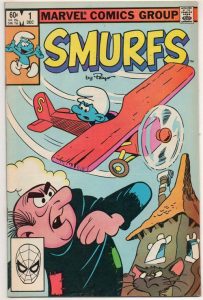
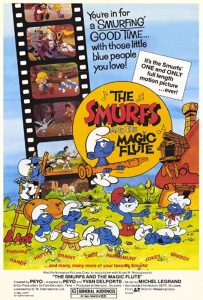
 Jim Korkis is an internationally respected animation historian who in recent years has devoted his attention to the many worlds of Disney. He was a columnist for a variety of animation magazines. With his former writing partner, John Cawley, he authored several animation related books including The Encyclopedia of Cartoon Superstars, How to Create Animation, Cartoon Confidential and Get Animated’s Animation Art Buyer’s Guide. He taught animation classes at the Disney Institute in Florida as well as instructing classes on acting and animation history for Disney Feature Animation: Florida.
Jim Korkis is an internationally respected animation historian who in recent years has devoted his attention to the many worlds of Disney. He was a columnist for a variety of animation magazines. With his former writing partner, John Cawley, he authored several animation related books including The Encyclopedia of Cartoon Superstars, How to Create Animation, Cartoon Confidential and Get Animated’s Animation Art Buyer’s Guide. He taught animation classes at the Disney Institute in Florida as well as instructing classes on acting and animation history for Disney Feature Animation: Florida.




















































Jim, regarding this part:
“For the United States though some changes had to be made. The biggest change was the addition of a new character, Smurfette. Peyo’s creation was a totally male universe. There were no females with the exception of some humans. To explain the presence of a single woman, the story crew devised a story where the Smurfs main nemesis, a generally inept sorcerer named Gargamel, creates a female Smurf to trap the blue creatures.
However Papa Smurf uses his magic and turns the scheming vixen into the ever friendly and helpful, Smurfette. (Actually, Peyo used a similar story to introduce a Smurfette in one of his comic adventures, but she did not remain as a regular character.)”
I don’t know where you got the information that Hanna-Barbera “invented” Smurfette or wrote her introductory story by themselves… but it’s blatanty untrue. The character was created by Peyo in 1966, and introduced into the Smurfs comics in exactly same way that Hanna-Barbera later introduced her for their TV adaptation. In fact, Hanna-Barbera’s first TV episode with Smurfette was directly based on Peyo’s comics story from the 1960s.
Reading these paragraphs, I get the feeling that you started out writing them under the impression that Smurfette was a Hanna-Barbera creation, then at the last minute found out that she wasn’t, and added the parenthesis about Peyo. But what you write still comes off as very confusing, considering that the Smurfette featured in H-B’s TV series was the exact same character that Peyo created 15 years earlier. (From what I understand, though, Smurfette became a *regular* character in the comics only after the TV series featured her that way.)
A smurftastic post, only slightly besmurfed by a minor misconsmurftion. The term “Schtroumpf” was coined by Peyo; it’s a Gallic transliteration of Strumpf, the German word for stocking, referring to the Stroumpfs’ characteristic leggings. Like most German words, it sounds funny to French-speakers. It only later acquired its present meaning because of the Stroumpfs’ habit of substituting the name of their race for random words, as the Smurfs do in English. (Peyo was half English. He adopted his nom du smurf because that was how one of his English cousins pronounced Pierrot, the diminutive form of his given name, Pierre.)
That’s an interesting account of Smurfette’s origin. I know a lot of viewers have noted the grossly uneven sex distribution ratio in Smurf society and have speculated wildly about Smurf reproduction. I remember seeing a movie where a couple of guys getting drunk in a bar did just that.
For lovers of classical music, the Smurf soundtracks were delightful . A typical cartoon quoted at least a dozen classical works, and it was fun to play “Name That Tune” as you went along. The Sultan’s theme from Scheherazade functioned as a leitmotif for Gargamel.
I know a tuba player who has a little figurine of a tuba-playing Smurf, which he places on the floor at his feet during rehearsals and concerts as a sort of talisman — evidence of the cartoon’s smurfy legacy. Consmurfulations on a most smurfy article! La la la la la la, la la la la la….
Ah yes! The utilization of classical music in the Smurfs was always one of my favorite aspects of the cartoon.
Peyo would look at a frame of film and state the drawing was wrong and out of proportion.
Ha!-Bill Melendez said Charles Schulz did the exact same thing when “Peanuts” was first adapted to animation.
Always thought it amusing that Standards & Practices wouldn’t allow Brainy to be clubbed with a mallet by his fellow Smurfs as in the original comics, and instead had to be tossed offscreen (shades of Mildew Wolf).
That’s why it’s lucky Melendez had a head start with Tweety in how to animate a character with short little legs and a big head.
I interviewed the late Kip King, who played Tailor Smurf. Here’s what he said about the series:
I get a call from my commercial agency, “You’re gonna do a voice on CAPTAIN CAVEMAN.” I never heard of CAPTAIN CAVEMAN so I go around to Hanna Barbera and there’s Mel Blanc and I’m the guest villain. That’s all. They put me in it and I started doing that. Then they put me in one thing or another and I started doing THE SMURFS. They never tell you if you’ve got something, you know? So I show up, they say, “Yeah, you’re gonna play a smurf.” So I go down and they like my character who (in character) “talked like THIS!” Originally, Tailor was the closest thing to a Jewish smurf they could have. They speed up the voice. It has to be higher so (in character) “instead of talking like this,” he talked like THIS” and then they speed it up just a bit. “So he became a little precious.” They said he was a little too Jewish, then a little too fey, so they toned it down and it became Tailor. By the way, they had a lot of smurfs be a smurf just for one show So I did that one show and from that show came nine years of work. So that’s amazing. My son got me for my birthday an original cel of Tailor with all the original background, too.
Plus, I went to a party for (SMURFS creator) Peyo when I was doing THE SMURFS and he autographed one (sketch) of my character and he wrote, “For Kip, the voice of my Smurf.”
Many mistakes in this article, some allready pointed in the replies on top. “La Flûte à Six Schtroumpfs”, feature film was made in the early 70’s, way before the Hanna&Barbera series. It was produced by Belvision and Dupuis. Dupuis also made a tv-series in 1960. Yvan Delporte, script-writer for Peyo on the comics, was fluent in english and helped on the production. It seems that americans keep considering foreign imported culture very lightly! Very bad cartoon researching here!
Though it should be noted that Belvision’s 1960 Smurfs series was stop-action animation in monochrome.
Of note, too, is where, for that same season, another Smurfs-inspired series also came from Hanna-Barbera, by name of Trollkins, which one critic lovingly described in concept as “Dukes of Hazzard meets J. R. R. Tolkein.” And to make things interesting, CBS scheduled Trollkins opposite Smurfs at 8:30 Eastern/Pacific on Saturday mornings in the 1981-82 season, only to be moved to 12 noon later in the season to improve ratings.
There was also “The Biskitts”, another H-B-produced CBS series, taking place in a medieval setting, where the folks were miniature dogs living in an equally-scaled castle hidden in a swamp, left to guard precious treasures from previous kingdoms. That show also had Kip King among the featured actors playing King Max’s royal jester Schecky.
A crucial issue in the Smurfs’ animated debut was the FCC’s then position of banning shows based on toys. The Smurfs got America’s attention first through toys, but when H-B learned they were based on a Belgian comic book, they cited that as the underlying literary property.
“the Schtroumpf (the Flemish word for “watchamacallit”)” -> except it isn’t, it’s a made-up word. How it originated is a well-known story : Peyo was having dinner with fellow cartoonist André Franquin and asked him for salt, substituting the word salt for Schtroumpf. Peyo wasn’t flemish, he’s from Brussels. The dutch name for the characters is De Smurfen.
“The biggest change was the addition of a new character, Smurfette. Peyo’s creation was a totally male universe. There were no females with the exception of some humans.” -> wrong again, the Smurfette was created in 1966. The storyline she appeared in is all about her. She appeared in most of the comic books after that and definitely was a regular.
Talking of birth or creation about the tv series is a bit overstating ; most of the stories of the first seasons are adapted from the comic books. Delporte rewrote all the scripts and was already involved in the comic books since 20 years, so it hardly was a new take. The main differences are about some defined Smurfs like the clumsy or the brainy one, and the black Smurfs who became purple. Oh and of course, the cruder artwork.
Cruder artwork? Have you seen the international 1960’s black and white series by Belvision? It makes H-B’s series look like “Snow White” by comparison (incidently, unsung animator Volus Jones, who started his animating career as an in-betweener for “Snow White”, worked on H-B’s Smurfs).
The H&B series were adapted from the comic books, not from the TVA cartoons – so I stand on my point, that art is way cruder than Peyo’s original drawings. By the way the TVA cartoons were an early attempt from the burgeoning belgian animation industry, you can hardly compare it to an international tv series made by a large american studio – not the same times, budget, audience. TVA had no experience so yeah, those cartoons were not unforgettable ; meanwhile, H&B had no such excuse.
“The Smurfs” represent the last gasp of Hanna-Barbera’s dominance of Saturday morning. Marvel put out the comics, huh? I’m surprised Disney hasn’t co-opted the little blue buggers. (Disney’s credo: if you can’t create it, buy it.)
They have other things in mind. Plus, Marvel only did a one-shot, not a series.
I think you confused Wallace for Russ Beerie. Wallace was an actor who didn’t get into making toys and plush. Russ did, and the company was better known for its name change to Applause.
The word ‘smurf’ is not an English invention, the creatures already got this name in Dutch, the other language spoken in Belgium, the Smurfs’ country of origin.
I found this here https://abancommercials.com/uk-ad/3653/lidl-stikeez-smurfs-ireland-advert